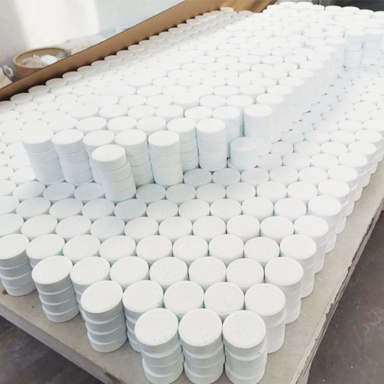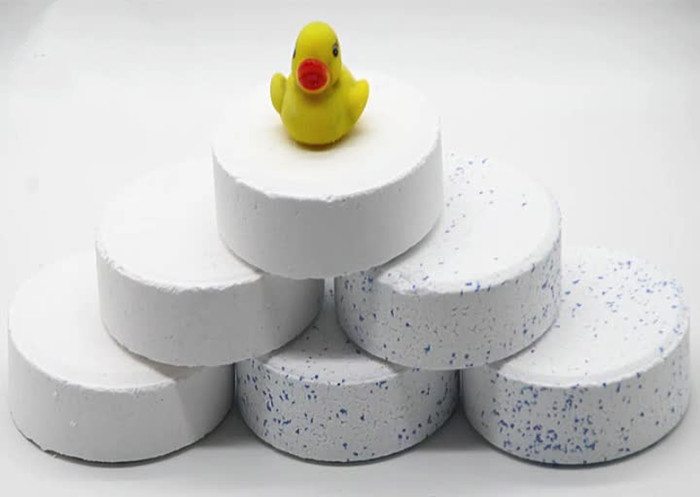One of the busiest spots for people to briefly get away from the heat and relax during the summer is the swimming pool. Behind a transparent and crystal-clear pool are chlorine tablets quietly doing their job of purifying the water. Since ancient times, from the traditional method of disinfection to the current widespread application, pool chlorine tablets have served a significant role in ensuring the healthiness of pools with their powerful disinfection, sterilization, and algae-dissolving functions.
I. A century of disinfection history
Tracing back to where the disinfection technology for the swimming pool originated, chlorine was first pumped into the London, England tap water system in 1897, marking the beginning of chlorine disinfection. In those times, swimming pools used gaseous chlorine or liquid sodium hypochlorite as disinfectants. Though good at killing bacteria, these disinfectants are very corrosive and very dangerous to ship. In addition, they are prone to forming carcinogens with trihalomethanes when being disinfected, and their safety is of concern.
It was not until the 1950s that the arrival of solid chlorine tablets heralded the breakthrough in the swimming pool disinfection practice. It turned out to be a fast achiever in the market with safe handling and storage, and stable slow slow-release properties. Compared with gaseous and liquid chlorine, tablets not only have a more convenient application but are also better at controlling dosage; the corrosion of equipment, along with the risk of injury to the human body, is less, too. So it gradually became the mainstream disinfectant option for swimming pools. Today, chlorine products have commanded over 70% of the global swimming pool disinfection market. The chlorine tablets, as the “main force” among them, continue to innovate with continuous adaptation to market demand.
II. Core functions
The general components of chlorine tablets are normally trichloroisocyanuric acid or sodium dichloroisocyanurate. Dissolved in water, the components will disintegrate to form hypochlorous acid, which possesses excellent oxidizing capacity. It can penetrate the cell membranes of microbes like bacteria and viruses, damage their intracellular enzyme systems and nucleic acid structures, and thereby function as effective sterilization. Whether it is normal Escherichia coli, Staphylococcus aureus, or enteroviruses with a pathogenic tendency, it is difficult to survive in water with an adequate proportion of chlorine.
Other than sterilizing, chlorine tablets are also effective at inhibiting algae growth. Algae want to multiply in a warm, light, and nutrient environment. Once contaminated by algae, the water turns green and turbid and even emits an odor. Chlorine released by chlorine tablets has the effect of changing the redox potential of the water, killing the living habitat of algae, suppressing their photosynthesis, and suppressing the growth and reproduction of algae from the root. Furthermore, the tablets are also essential for breaking down organic materials. For example, sweat and grease carried into the swimming pool by swimmers and airborne dust suspended within the air may all be destroyed by the oxidation of chlorine.

III. Multi-dimensional comparison
If compared to other disinfectants, chlorine tablets possess several distinct advantages. Take bromine, for instance. Although it shows intense bactericidal activity even at low temperatures and is less irritating to the eyes and skin, its exorbitant cost is sometimes a serious limitation. Also, when applied to disinfecting water with a high organic load, its disinfecting effectiveness is significantly decreased. Conversely, chlorine tablets have an advantage in all instances, due to their affordability and broad-spectrum antibacterial activity.
Disinfection with ozone, though, possesses a huge advantage of being extremely strong oxidizing, quick disinfection, and without the residue effect. It has its disadvantages too. Disinfection machines with ozone are very expensive to purchase and also to operate. Besides, it cannot be utilized for continuous sterilization and, in most situations, would need to be supplemented by the use of disinfectants. In contrast, chlorine tablets allow slow-release disinfection for extended time intervals, creating a constant amount of effective chlorine within the pool water and ensuring water quality safety in the long term.
Electrolytic salt disinfection is environmentally friendly, but is nonetheless technology-intensive and calls for strict water quality controls. Chlorine tablets, however, offer unparalleled flexibility. They are adaptable to any type of swimming pool, from large public pools and hotel pools to small domestic pools. Ease of application and superior disinfection efficiency make them the first choice for pool operators seeking a reliable and convenient solution.
Conclusion
Since their discovery and widespread use, pool chlorine tablets have been dedicated to ensuring water safety. Although small, they’re critical to a safe swimming experience. As water quality needs evolve, chlorine tablets will keep developing to safeguard each swim.
As a chlorine tablet manufacturer and wholesaler, I will emphasize the product advantages and cooperation sincerity in the conclusion, and show professionalism and service enthusiasm.
Being a trustworthy chlorine tablets manufacturer and wholesaler, we’re committed to quality. Through strict standards and innovative technology, we produce efficient, reliable tablets for clear pool water. Ranging from bulk orders for large pools to custom-made products for private pools, we offer tailor-made products and committed service. Choose us, you’re choosing safety, reliability, and a sound partnership.

 Instant
Quote
Instant
Quote Email
Us
Email
Us